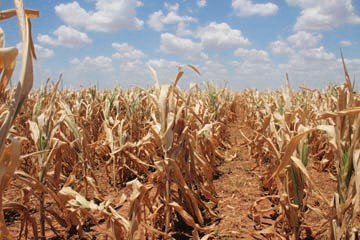Experts predict drought could be around for years to come
The bad news is, Texas is in the strangehold of the second-most severe drought in state history and the worst ever for a single year.
The badder news: Get used to it. The drought may be around for the next year or two.
And, yes, global warming may be a contributing factor. Climate scientists predict much more of the same in coming decades because of long-term warming trends.
Texas is poised to surpass a 1956 dry spell and record its worst drought on record if high heat and low rainfall persist beyond summer. Get used to it, say scientists who point to climate models and historical patterns as confirmation that subtropical areas across the southern United States are permanently drying out.
Conditions that used to be considered extreme are fast becoming the norm, says climate scientist Richard Seager of Columbia University.
“There were some historical droughts, like in the ‘30s and ‘50s, that went on for years and years on end,” Seager observes. “That level of aridity will become the new climatological state by the middle of the century.”
More bad news: Not much can be done to slow the drying trend in coming decades, Seager says.
To be sure, no one is yet predicting that the current drought will challenge the life-altering drought of the 1950s, the benchmark to which all other droughts in Texas are compared. That parched period, which ran from 1947-57, has been called “the most costly and one of the most devastating droughts in 600 years.”
“The drought we’re in is severe, but it ain’t your grandpa’s drought,” says Robert Mace, the Texas Water Development Board’s deputy executive administrator.
Almost 65 years ago, it stopped raining in central Texas in spring 1947. By summer 1951, nearly the entire state was in drought.
But by the time that 10-year drought was declared over, Texas had been reshaped, and farming and ranching had changed forever. Many ranchers abandoned the agricultural life which had been their legacy, having long before liquidated their stock at heartbreaking, emergency prices.
Already this year, drought has led to farmers abandoning crops, ranchers thinning herds, record-setting electricity usage and a record-breaking wildfire season.
Today, after enduring nearly a year of drought, Texans have grown accustomed to seeing acres of withered crops, countless dried-up ponds and mile after mile of cracked earth.
Ask Gonzales County extension agent Dwight Sexton about the state of agriculture, and he sums it up in four words: “Drought, drought and drought.”
“[Texas] can get by without a lot of rain, but we just need some rain,” Sexton says. “We haven’t gotten much rain.”
Sexton says ranchers have a few options for weathering the drought: Destock and sell their cows, locate a source of feed and hay and finance it, or send their livestock elsewhere where pastureland can sustain the herd.
“The same answer is not right for everyone,” Sexton cautions. “Everyone’s [situation is] different.”
But he does offer a glint of hope for those who survive the drought.
“For those who can stay in, the cattle market is predicted to be strong. That’s the light at the end of the tunnel.”
Even those ranchers who are able to stay the course will likely alter the way they do business. “I don’t think anyone is going to restock in the spring the way they did a couple of years ago,” Sexton predicts.
Drought, of course, is an equal-opportunity disaster. The plight of ranchers and farmers get the most attention, but miniscule rainfall and triple-digit temperatures affect everyone.
“Drought is affecting everything – rural crop producers, landowners with trees,” Sexton says. “Pasture grasses will die out, folks with lawns will see a lot thinner lawns.”
And there’s no relief in sight. The La Nina weather phenomenon which is being blamed for the crippling lack of rain might be back soon, just two months after the last La Nina ended, according to the U.S. Climate Prediction Center.
Experts predict that it’s likely at least parts of the state will have severe drought again next summer, and maybe beyond that. Looking into their “crystal ball,” those same experts say chances are favorable that at least parts of Texas will continue to experience a drought that will stretch on for two or more years.
If that happens, climatologists say water supply problems could be even worse than they are now.
Add rising temperatures to the equation, and the region could be even drier.
“It looks like Texas is turning into a desert state,” says Carl Anderson, a Texas A&M extension professor emeritus. “At this time, I’d estimate that three million of the 7.1 million acres planted this season will be abandoned – the largest abandonment since 1981.”
Others observe that there is no situation in recent times comparable to what we’re seeing this year. July was the hottest month ever on record for both Texas and Oklahoma, and both states experienced some of the lowest levels of July precipitation since the 1880s. Several cities in both states have set new records for the most consecutive days with high temperatures of 100 degrees or higher.
“Everybody’s not in quite as good a mood as they could be,” Sexton says of the drought’s affect. “It just kinda beats you down.”
Comments







